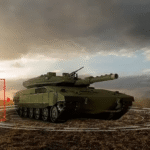From September 3 to 19, 2025, the U.S. Air Force, in collaboration with NORAD and USNORTHCOM, is conducting Falcon Peak, a major counter-Unmanned Aerial System (c-UAS) experiment at Eglin Air Force Base, Florida. The exercise, held daily from 7 a.m. to 7 p.m., aims to rigorously test multi-layered defenses against small drone threats launched from Santa Rosa Island.
Testing Environment & Objectives
Realistic simulated attacks: Small UAS are launched over nearby areas to assess detection, tracking, identification, and defeat capabilities.
Key technologies evaluated:
Advanced radar systems
RF and GNSS jamming tools
Directed-energy weapons (e.g., lasers or high-power microwaves)
Kinetic interceptors
These technologies are tested not in isolation, but as part of an integrated data-sharing architecture that enables real-time threat response—reflecting alignment with the JADC2 initiative.
Strategic Significance
Base defense modernization: Falcon Peak is described as a “critical milestone” in scaling defense systems against rapidly proliferating small drone threats—used for surveillance and strikes in multiple conflict zones and now extending to U.S. territory.
Roles of organizations:
96th Test Wing and First Air Force (AFNORTH) oversee operations at Eglin.
Infrastructure and proximity to Gulf airspace make Eglin ideal for high-risk testing.
Doctrine and acquisition impact: Results will inform c-UAS procurement via the Joint Counter-small Unmanned Aircraft Systems Office (JCO) and shape new Tactics, Techniques, and Procedures (TTPs) for both CONUS and expeditionary installations.
Broader messaging: The exercise signals recognition that drones are no longer emerging threats but enduring ones, demanding immediate, scalable, integrated defenses.
Local Reporting & Public Awareness
Regional media attention confirms Falcon Peak’s scope and timing: a two-week testing window beginning September 3, off Santa Rosa Island, daily from morning to evening.
Technical Integration in Defense Strategy
The multi-domain integration of c-UAS systems tested in Falcon Peak echoes broader Department of Defense efforts such as JADC2, aimed at connecting sensors to shooters across land, air, sea, space, and cyber domains. Falcon Peak may serve as a practical implementation case of this architecture, particularly for small UAS defense.
Key Points
When & Where: September 3–19, 2025; Eglin AFB, utilizing Santa Rosa Island launch zone.
Agencies Involved: U.S. Air Force (96th Test Wing, AFNORTH), NORAD, USNORTHCOM, defense contractors, research agencies.
Technologies Tested: Radar, jamming (RF/GNSS), directed-energy, kinetic interceptors, integrated networks.
Goals: Validate layered base defense, inform acquisition, refine TTPs, enhance doctrinal frameworks.









